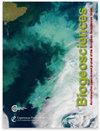Reviews and syntheses: Understanding the impacts of peatland catchment management on dissolved organic matter concentration and treatability
IF 3.9
2区 地球科学
Q1 ECOLOGY
引用次数: 0
Abstract
Abstract. In the UK, most large reservoirs constructed for public water supply are in upland areas. Many are situated in catchments characterised by organic-rich soils, including peatlands. Although these soils naturally leach large amounts of dissolved organic matter (DOM) to water, the widespread degradation of upland peat in the UK is believed to have exacerbated rates of DOM loss. High and rising DOM concentrations in these regions raise treatment challenges for the water industry. In the UK, water companies are increasingly considering whether upland-catchment peat restoration measures can slow down or even reverse rising source water DOM concentrations and, thus, reduce the need for more costly and complex engineering solutions. There remains considerable uncertainty around the effectiveness of such measures, and a comprehensive overview of the research in this area remains lacking. Here, we review the peer-reviewed evidence of the effectiveness of four catchment management options in controlling DOM release from peat soils: ditch blocking, revegetation, reducing forest cover and cessation of managed burning. Results of plot-scale investigations into the effects of ditch blocking on DOM leaching are currently largely equivocal, while there is a paucity of information regarding impacts at spatial scales of more direct relevance to water managers. There is some, although limited, evidence that the terrestrial vegetation type may influence DOM concentrations and treatability. The presence of plantation forestry on peat soils is generally associated with elevated DOM concentrations, although reducing forest cover appears to have little short-term benefit, and associated disturbance may even increase concentrations further. Catchment management measures have rarely been monitored with downstream water quality as the focus. To mitigate the uncertainty surrounding restoration effects on DOM, measures should be undertaken on a site-specific basis, where the scale, effect size and duration of the intervention are considered in relation to subsequent biogeochemical processing that occurs in the reservoir, the treatment capacity of the water treatment works and future projected DOM trends.综述与综合:了解泥炭地流域管理对溶解有机质浓度和可处理性的影响
摘要在英国,大多数为公共供水而建造的大型水库都位于高地地区。其中许多位于集水区,其特征是有机土壤丰富,包括泥炭地。尽管这些土壤自然地将大量溶解的有机物(DOM)滤出到水中,但英国高地泥炭的广泛退化被认为加剧了DOM的损失率。这些地区DOM浓度高且不断上升,给水行业的处理带来了挑战。在英国,水务公司越来越多地考虑,高原集水区泥炭恢复措施能否减缓甚至逆转水源水中DOM浓度的上升,从而减少对更昂贵、更复杂的工程解决方案的需求。这些措施的有效性仍然存在相当大的不确定性,对这一领域的研究仍然缺乏全面的概述。在这里,我们回顾了同行评议的证据,证明了四种集水区管理方案在控制泥炭土DOM释放方面的有效性:沟渠阻塞、植被恢复、减少森林覆盖和停止管理燃烧。目前,对沟渠阻塞对DOM浸出影响的图尺度调查结果在很大程度上是模棱两可的,而在空间尺度上与水管理人员更直接相关的影响方面的信息缺乏。有一些尽管有限的证据表明,陆地植被类型可能影响DOM浓度和可处理性。泥炭土上人工林的存在通常与DOM浓度升高有关,尽管减少森林覆盖似乎没有什么短期利益,相关的干扰甚至可能进一步增加浓度。很少以下游水质为重点监测集水区管理措施。为了减轻修复对DOM影响的不确定性,应根据具体地点采取措施,考虑干预措施的规模、效果大小和持续时间,以及随后在水库中发生的生物地球化学处理、水处理厂的处理能力和未来预测的DOM趋势。
本文章由计算机程序翻译,如有差异,请以英文原文为准。
求助全文
约1分钟内获得全文
求助全文
来源期刊

Biogeosciences
环境科学-地球科学综合
CiteScore
8.60
自引率
8.20%
发文量
258
审稿时长
4.2 months
期刊介绍:
Biogeosciences (BG) is an international scientific journal dedicated to the publication and discussion of research articles, short communications and review papers on all aspects of the interactions between the biological, chemical and physical processes in terrestrial or extraterrestrial life with the geosphere, hydrosphere and atmosphere. The objective of the journal is to cut across the boundaries of established sciences and achieve an interdisciplinary view of these interactions. Experimental, conceptual and modelling approaches are welcome.
 求助内容:
求助内容: 应助结果提醒方式:
应助结果提醒方式:


